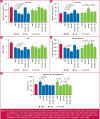Mitochondrial oxidative phosphorylation and mitophagy in myocardial ischaemia/reperfusion: effects of chloroquine
- PMID: 31995116
- PMCID: PMC8762801
- DOI: 10.5830/CVJA-2019-067
Mitochondrial oxidative phosphorylation and mitophagy in myocardial ischaemia/reperfusion: effects of chloroquine
Abstract
Aim: The aim of this study was to evaluate the temporal relationship between mitochondrial oxidative phosphorylation and mitophagy in rat hearts subjected to ischaemia/reperfusion. Measurements were made at specific points during the experimental protocol (snapshot approach) and by assessments of mitophagic flux, using chloroquine pre-treatment.
Methods: Isolated working rat hearts were subjected to 25 or 30 minutes of global ischaemia/10 minutes of reperfusion. Half of each group received chloroquine (10 mg/kg, intraperitoneally) one hour before experimentation. Mitochondria were isolated after stabilisation, ischaemia and reperfusion, and oxidative phosphorylation was measured polarographically. Mitochondrial mitophagy markers were detected by Western blot analysis.
Results: Mitochondrial oxygen uptake (state 3) and oxidative phosphorylation rate were reduced by ischaemia and increased by reperfusion. Chloroquine pre-treatment increased both parameters. Using a snapshot approach, exposure to ischaemia ± reperfusion had little effect on mitochondrial PINK1, Parkin and p62/SQSTM1 expression. Ischaemia reduced Rab9 expression, and reperfusion upregulated the phosphor DRP1, phosphor/total DRP1 ratio and Rab9 levels. Chloroquine significantly reduced PINK1, p62/SQSTM1, Rab9 and particularly Parkin expression during reperfusion, without an effect on mitochondrial total and phospho DRP1 levels.
Conclusions: Ischaemia/reperfusion-induced changes in mitochondrial oxidative phosphorylation function occurred concomitantly with changes in mitophagic flux. Pre-treatment with chloroquine profoundly affected mitochondrial function as well as the pattern of mitophagy during ischaemia/reperfusion.
Keywords: DRP1; Parkin; Rab9; mitochondrial oxidative phosphorylation; mitophagy; myocardial ischaemia/reperfusion; p62/SQSTMI; PINK1.
Figures





Similar articles
-
Mitochondrial Oxidative Phosphorylation Function and Mitophagy in Ischaemic/Reperfused Hearts from Control and High-Fat Diet Rats: Effects of Long-Term Melatonin Treatment.Cardiovasc Drugs Ther. 2020 Dec;34(6):799-811. doi: 10.1007/s10557-020-06997-9. Cardiovasc Drugs Ther. 2020. PMID: 32458321
-
Dapagliflozin Alleviates Myocardial Ischaemia Reperfusion Injury by Activating Mitophagy via the AMPK-PINK1/Parkin Signalling Pathway.Curr Vasc Pharmacol. 2024;22(3):203-217. doi: 10.2174/0115701611269801231211104905. Curr Vasc Pharmacol. 2024. PMID: 38141195
-
Hydralazine protects the heart against acute ischaemia/reperfusion injury by inhibiting Drp1-mediated mitochondrial fission.Cardiovasc Res. 2022 Jan 7;118(1):282-294. doi: 10.1093/cvr/cvaa343. Cardiovasc Res. 2022. PMID: 33386841 Free PMC article.
-
Mitochondrial quality control in cardiac microvascular ischemia-reperfusion injury: New insights into the mechanisms and therapeutic potentials.Pharmacol Res. 2020 Jun;156:104771. doi: 10.1016/j.phrs.2020.104771. Epub 2020 Mar 28. Pharmacol Res. 2020. PMID: 32234339 Review.
-
Roles of mitochondrial dynamics modulators in cardiac ischaemia/reperfusion injury.J Cell Mol Med. 2017 Nov;21(11):2643-2653. doi: 10.1111/jcmm.13330. Epub 2017 Sep 22. J Cell Mol Med. 2017. PMID: 28941171 Free PMC article. Review.
Cited by
-
Novel mechanistic insights of the potential role of gasotransmitters and autophagy in the protective effect of metformin against hepatic ischemia/reperfusion injury in rats.Naunyn Schmiedebergs Arch Pharmacol. 2025 Jul;398(7):9177-9198. doi: 10.1007/s00210-025-03837-1. Epub 2025 Feb 6. Naunyn Schmiedebergs Arch Pharmacol. 2025. PMID: 39912902 Free PMC article.
-
Identification and experimental validation of mitochondrial and endoplasmic reticulum stress related gene in diabetic nephropathy.Sci Rep. 2025 Aug 7;15(1):28980. doi: 10.1038/s41598-025-11097-5. Sci Rep. 2025. PMID: 40775242 Free PMC article.
-
Small Rab GTPases in Intracellular Vesicle Trafficking: The Case of Rab3A/Raphillin-3A Complex in the Kidney.Int J Mol Sci. 2021 Jul 18;22(14):7679. doi: 10.3390/ijms22147679. Int J Mol Sci. 2021. PMID: 34299299 Free PMC article. Review.
-
SARS-CoV-2 and mitochondrial health: implications of lifestyle and ageing.Immun Ageing. 2020 Nov 9;17(1):33. doi: 10.1186/s12979-020-00204-x. Immun Ageing. 2020. PMID: 33292333 Free PMC article. Review.
-
Protective effect of resveratrol on rat cardiomyocyte H9C2 cells injured by hypoxia/reoxygenation by regulating mitochondrial autophagy PTEN-induced putative kinase protein 1/Parkinson disease protein 2 signaling pathway.J Tradit Chin Med. 2022 Apr;42(2):176-186. doi: 10.19852/j.cnki.jtcm.20220311.002. J Tradit Chin Med. 2022. PMID: 35473337 Free PMC article.
References
-
- Ferrari R. Importance of oxygen free radicals during ischemia and reperfusion in the experimental and clinical setting. Oxygen free radicals and the heart. Am J Cardiovasc Pathol. 1992;4:103–114. - PubMed
-
- Ferrari R, Ceconi C, Curello S, Cargnoni A, Pasini E, De Giuli F, Albertini A. Role of oxygen free radicals in ischemic and reperfused myocardium. Am J Clin Nutr. 1991;53:215S–222S. - PubMed
-
- Watts JA, Kline JA. Bench to bedside: the role of mitochondrial medicine in the pathogenesis and treatment of cellular injury. Acad Emergency Med. 2003;10:985–997. - PubMed
-
- Zweier JL, Talukder MA. The role of oxidants and free radicals in reperfusion injury. Cardiovasc Res. 2006;70:181–190. - PubMed
MeSH terms
Substances
LinkOut - more resources
Full Text Sources
Miscellaneous

